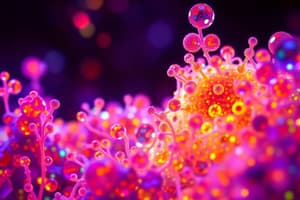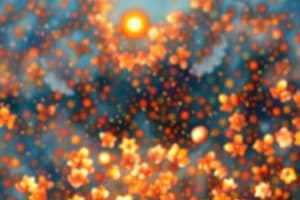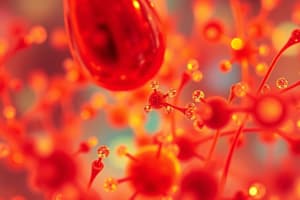Podcast
Questions and Answers
What are the 4 types of Light Microscopes?
What are the 4 types of Light Microscopes?
- Fluorescence Microscope (correct)
- Dark-field Microscope (correct)
- Phase contrast Microscope (correct)
- Bright-field Microscope (correct)
What is a Brightfield Microscope?
What is a Brightfield Microscope?
A microscope that allows light rays to pass through a slide/specimen and then through various lenses to the eye.
Microscopes are very expensive and must be handled with care.
Microscopes are very expensive and must be handled with care.
True (A)
How should microscopes be transported?
How should microscopes be transported?
What are the microscope parts and their functions?
What are the microscope parts and their functions?
What are the three lens systems in a microscope?
What are the three lens systems in a microscope?
What does total magnification equal?
What does total magnification equal?
What are the two focusing knobs?
What are the two focusing knobs?
Describe the ocular adjustment.
Describe the ocular adjustment.
Define resolution.
Define resolution.
Resolution is a function of what three things?
Resolution is a function of what three things?
What is the optimum resolution of the best microscope with the oil immersion lens?
What is the optimum resolution of the best microscope with the oil immersion lens?
How to increase resolution?
How to increase resolution?
What is numerical aperture (NA)?
What is numerical aperture (NA)?
What is the limit of resolution?
What is the limit of resolution?
What does parfocalization mean?
What does parfocalization mean?
Oil has the same refractive index as what?
Oil has the same refractive index as what?
Flashcards are hidden until you start studying
Study Notes
Light Microscopes
- Four types of light microscopes: Bright-field, Dark-field, Phase contrast, and Fluorescence.
- Bright-field microscope: Allows light transmission through specimens to magnify and visualize objects.
Microscope Care and Transport
- Microscopes are costly and require careful handling.
- Transport using one hand on the arm and the other under the base for stability.
Microscope Parts and Functions
- Arm: Supports all microscope components.
- Base: Provides stability as the bottom part.
- Stage: Platform for holding slides.
- Mechanical stage: Clamps slides and facilitates movement.
- Light source: Illumination component located in the base.
- Voltage control: Adjusts light intensity; lower settings prolong lamp life.
- Lens system: Comprises ocular, objective, and condenser lenses.
- Focusing knobs: Includes coarse and fine adjustment knobs.
- Ocular adjustment: Aligns eyepieces to create a single image.
Lens Systems
- Ocular lens: Eye piece with 10X magnification and multiple lenses.
- Objective lens: Four options on the nosepiece—Scanning (4X), Low power (10X), High Dry (40X), Oil immersion (100X).
- Condenser lens: Located beneath the stage, it collects and directs light for uniform illumination.
Magnification and Resolution
- Total magnification calculated as ocular magnification times objective magnification.
- Resolution defines the clarity to distinguish between two separate points.
Factors Affecting Resolution
- Influenced by numerical aperture, wavelength of light, and condenser design.
- Best resolution attainable with oil immersion lens is 0.2 micrometers.
Improving Resolution
- Utilize blue or green filters to reduce wavelength and enhance resolution.
- Elevate condenser to maximize light entry.
- Open diaphragm for increased numerical aperture.
- Apply immersion oil between slide and 100X objective for optimal clarity.
Numerical Aperture and Limits of Resolution
- Numerical aperture (NA) measures lens light-capturing ability, improves with oil usage and higher objectives.
- Limit of resolution defined by the formula: D = Wavelength / (NA condenser + NA of objective lens).
Parfocalization
- Refers to the ability of the microscope to maintain focus when switching between objective lenses.
Refractive Index of Oil
- Oil matches the refractive index of glass, preventing light diffraction and loss, ensuring sharper image quality.
Studying That Suits You
Use AI to generate personalized quizzes and flashcards to suit your learning preferences.




